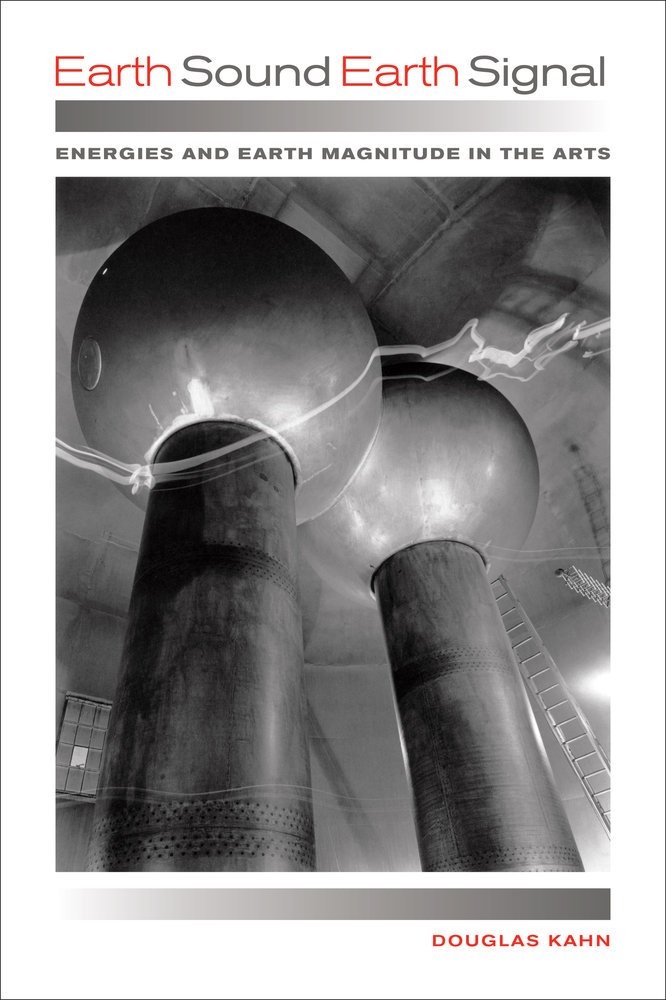Douglas Kahn: Earth Sound Earth Signal: Energies and Earth Magnitude in the Arts (2013)
Filed under book | Tags: · acoustics, art, art history, cold war, computer music, earth, electromagnetism, electronic music, energy, experimental music, geophysics, hearing, history of science, light, media history, music history, nature, noise, perception, radio, science, sound, sound art, sun, technology, telegraphy, telephone

“Earth Sound Earth Signal is a study of energies in aesthetics and the arts, from the birth of modern communications in the nineteenth century to the global transmissions of the present day. Douglas Kahn begins by evoking the Aeolian sphere music that Henry David Thoreau heard blowing along telegraph lines and the Aelectrosonic sounds of natural radio that Thomas Watson heard through the first telephone; he then traces the histories of science, media, music, and the arts to the 1960s and beyond. Earth Sound Earth Signal rethinks energy at a global scale, from brainwaves to outer space, through detailed discussions of musicians, artists and scientists such as Alvin Lucier, Edmond Dewan, Pauline Oliveros, John Cage, James Turrell, Robert Barry, Joyce Hinterding, and many others.”
Publisher University of California Press, 2013
ISBN 0520956834, 9780520956834
343 pages
Reviews: Alessandro Ludovico (Neural, 2013), Christopher Haworth (Organised Sound, 2015), Adam Trainer (Continuum, 2015).
PDF (removed on 2014-3-19 upon request of the publisher)
Comment (0)Ron Sakolsky, Stephen Dunifer (eds.): Seizing the Airwaves. A Free Radio Handbook (1998)
Filed under book | Tags: · community radio, free radio, media history, pirate radio, radio

“The first book to document and emphasize the myriad voices of the free radio movement, from Black Liberation Radio in Springfield, Illinois, to Free Radio Berkeley in Berkeley, California. The first section, “Media Monopoly And The Rise Of The Free Radio Movement” includes contributions from Robert McChesney on the political economy of radio in North America and a history and analysis of the burgeoning pirate radio movement. The second section, “On The Air,” includes interviews with and commentary by some of the key grassroots participants in micropower broadcasting worldwide—from Canada, Holland, Haiti, and Mexico, as well as America. The final section of the book consists of a comprehensive technical guide and how-to manual for going on the air, complete with schematics and “sound” advice.”
Publisher AK Press, 1998
ISBN 1873176996, 9781873176993
212 pages
via esco_bar
PDF (19 MB; updated on 2015-11-8)
Comments (2)Peter Krapp: Noise Channels: Glitch and Error in Digital Culture (2011)
Filed under book | Tags: · digital culture, electronic music, error, gaming, glitch, hacktivism, hypertext, machinima, media history, noise, sound art, tactical media, video games

Brings to light the critical role of noise and error in the creative potential of digital culture.
To err is human; to err in digital culture is design. In the glitches, inefficiencies, and errors that ergonomics and usability engineering strive to surmount, Peter Krapp identifies creative reservoirs of computer-mediated interaction. Throughout new media cultures, he traces a resistance to the heritage of motion studies, ergonomics, and efficiency, showing how creativity is stirred within the networks of digital culture.
Noise Channels offers a fresh look at hypertext and tactical media, tunes into laptop music, and situates the emergent forms of computer gaming and machinima in media history. Krapp analyzes text, image, sound, virtual spaces, and gestures in noisy channels of computer-mediated communication that seek to embrace—rather than overcome—the limitations and misfires of computing. Equally at home with online literature, the visual tactics of hacktivism, the recuperation of glitches in sound art, electronica, and videogames, or machinima as an emerging media practice, he explores distinctions between noise and information, and how games pivot on errors at the human–computer interface.
Grounding the digital humanities in the conditions of possibility of computing culture, Krapp puts forth his insight on the critical role of information in the creative process.
Publisher University of Minnesota Press, 2011
Volume 37 van Electronic Mediations
ISBN 0816676240, 9780816676248
216 pages
Download (removed on 2012-6-30 upon request of the Digital Assets Coordinator of the University of Minnesota Press)

